Pippi
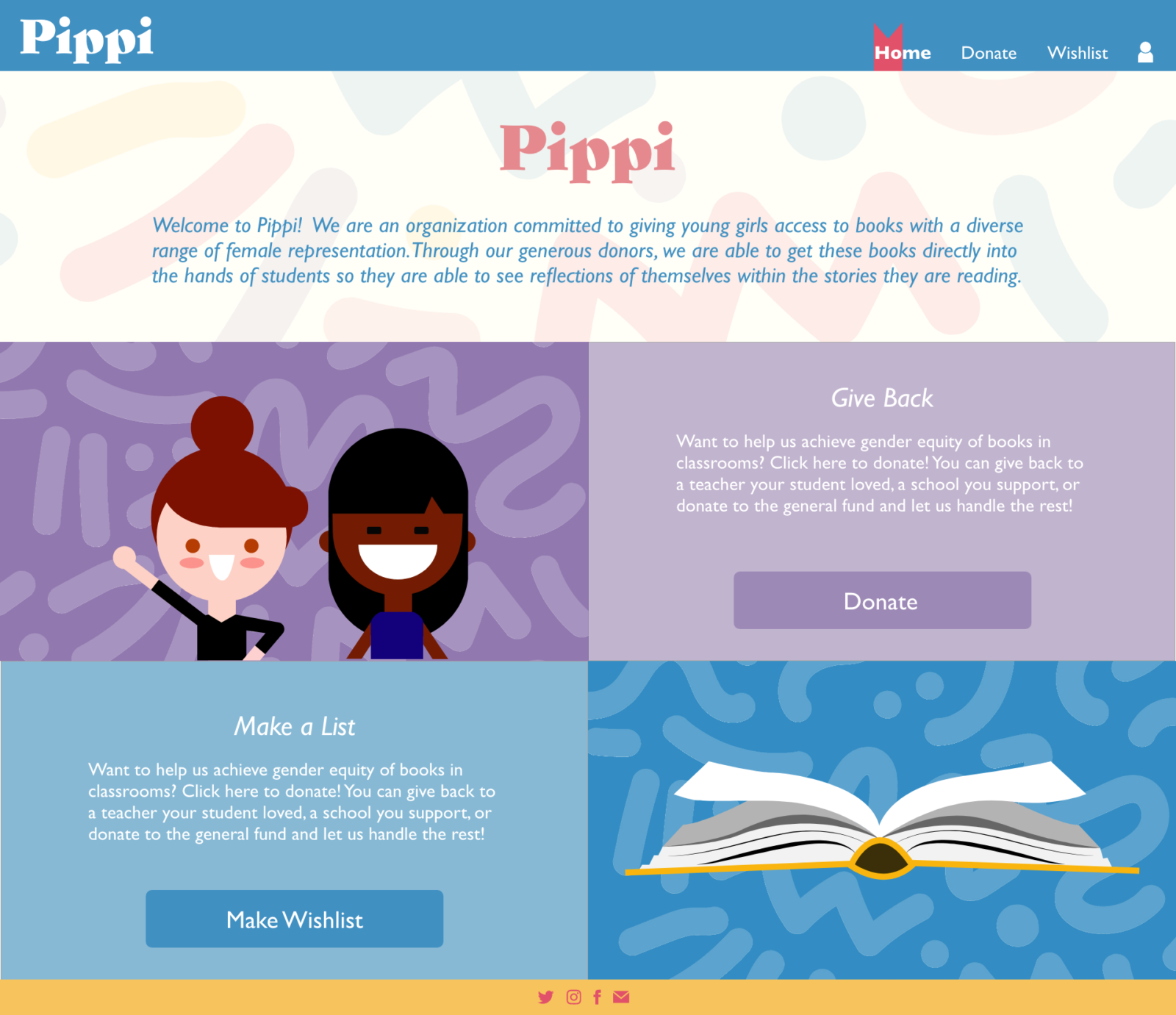
The Problem
From a very young age, children begin to learn about the world. This is accomplished through their parents and their teachers but one major way their worldview is shaped comes from the books they consume. It has been seen that the material and media they receive in schools that the characters seen within these stories can even go as far as to shape career paths for children (Chatfield, Georgina). A major takeaway those who study this phenomenon have found is that there is a severe lack of women’s representation as the main characters of children’s books which can subliminally lead to a very limited viewpoint of what females can do or accomplish. Beyond this, the female characters we do receive are portrayed as almost exclusively mothers, again contributing to this limited idea of the options girls will have later in their lives (Bailey, Catherine). As children aren’t old enough to supply what they read, it is important for teachers to have on hand a wide range of stories to allow female students to feel represented in their consumption of media, and begin to expose them to the broad amount of opportunities they may have when they are older (Lynch, Lisa).
How might I help aspiring teachers make sure their students have access to picture books with a diverse* range of female characters and roles represented in the classroom?
*Diverse meaning beyond stereotypical roles like mother
Success Statement
Teachers will be able to stock their classrooms with children’s books that show a range of different roles for women without having to come up with the funds themselves. This can also help them see options of good books for their students, and allow them to begin evening out the gender representation within their own library.
Target Audience
My target audience began as just aspiring teachers at Miami University but my eventual solution does expand out to be accessible to all teachers. My hope is that, because most of the literature that shapes children’s worldview comes from the classroom, this will help to illustrate the opportunities available to them when they are older. Targeting the children directly unfortunately isn’t an option because the books they have access to are given to them by either their parents or their teachers.
Research
To research this problem, I dove into three different types of information gathering. I conducted a content analysis, a literary review, and interviews of both current and aspiring teachers.
By performing a content analysis, I hoped to look into children’s picture books to get a more accurate sense of the content itself because I haven’t seen them recently. I wanted to find the baseline to operate from and see where diverse female representation is, if it is in bookstores etc. at all. This method is important because I needed to physically see the subject matter since I am making an argument that this diverse representation doesn’t exist in the US and to show that there is a standard that needs improving. After conducting this research I discovered how pervasive this problem actually was. When I analyzed displays ad libraries in March, there didn’t seem to be an issue because it was Women’s History Month. Their book displays were meant to promote diversity in this time. When I went again after that. I discovered that it was just as I thought, the displays were transformed back to normal and there were very few female characters on the covers of the books. I witnessed the phenomenon of the default male in many of the non-human characters which is when the gender of the animal is not known, it is immediately referred to as male. The inverse almost never happens.With confirmation of my hypothesis, I moved on to my other forms of research.
When looking into this topic I had seen that there was a decent amount of study into the impact of a lack of representation which I can learn from. Because of this, I chose to undergo a literary review. I needed to be informed on the implications of a lack of representation as well as the current reality of this space so I could know where to begin. This type of research can give me quantitative data about female characters as well as more qualitative data on the numbers’ impact. Reviewing the work of others is meant to help my project feel grounded in fact and research and explained why a push like this is growing and necessary. What I found in other sources confirmed many of my own suspicions. It has been seen and largely studies that children who aren’t exposed to character or images that reflect themselves gain a skewed worldview and grow up to see themselves as less capable. There were also studies conducted using AI to quantify how pervasive the issue is. One study even found that males are 2x more likely to be the main character than females, even when animals or other “non-gendered” characters are removed (Chatfield, Georgina). Another found that “for central characters, 61.0 % of books featured a male in the central role compared with 37.3 % that featured a female. […] Male animals were central characters in 23.2 % of books, whereas only 7.5 % of the analyzed literature included female animals as central characters” (Lynch, Lisa). Statistics such as these were incredibly common throughout my review.
I also knew it would be incredibly important to speak with teachers directly to find out more about their book selection process and how they feel about their current libraries. I also chose to speak with education majors who are about to go out into the field as teachers to try and find how I can help them as well as how they feel about this problem. First hand experience is vital as the teachers are who I am directly trying to help. An important insight that I gathered which shaped a large portion of this project was that stocking a classroom library is expensive and they are usually paying out of pocket to do it. Since this can add up so quickly they like to shop at thrift stores and other sales but they have a limited selection there that can take a long time to sort through and find something they want to offer to their students. I also learned that they will sometimes pick books for the class to read based on whether or not it has a pre-made lesson plan because teachers are busy. As much as they would like to spend time on things like these, it may not be an option because of work, grading, and trying to have their personal time. There were also an interesting amount of people who knew this was an issue but don’t have the means to combat it and a group that had no idea this issue and existed and want to hear more about it. For the purposes of this project, I will be focussing on those who are aware and want to fix this issue.
Design Process + Testing
The branding for this design solution changed over the course of the process. I always knew I wanted the solution to look playful and colorful because even though the solution isn’t specifically targeting children, I wanted the concept of them being the secondary audience to be very present. Originally I was thinking I wanted to embrace a very primary color inspired design, relying on the traditional school colors you see in young kids classrooms of red, blue, yellow, and green. While messing with these possible solutions, I found that there were many secondary associations that were being created depending on which colors I used together and I wanted this brand to stand alone and not distract from the message so I revised it. I stepped away from trying to figure out the colors and worked on developing the title of the work. I made word maps and lists trying to find what I wanted to call my service and I kept thinking about the case study which started this whole endeavor. It was about Pippi Longstocking and, though she was very popular in Sweden, they were still experiencing a severe deficit of female representation. Because of this I chose “Pippi” which maintains the childish feeling I want to evoke but is also a callback to my inspiration. I then made my new color scheme based on the colors of the animated character.
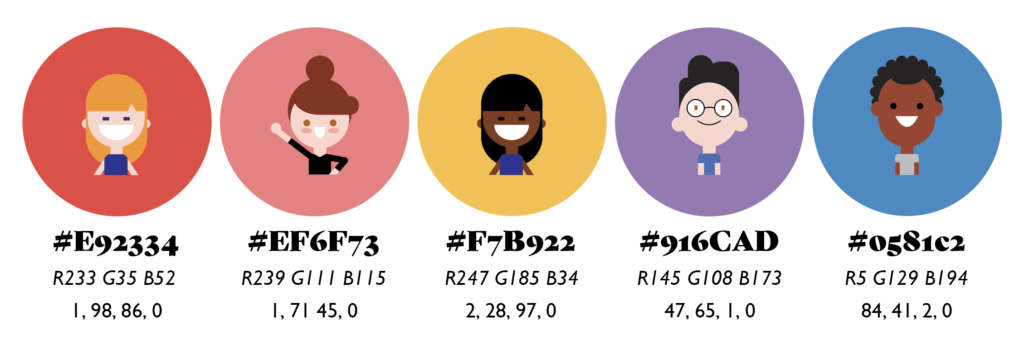
Color Swatches, Fonts, & Illustration Style
Once I established the brand and identity, I then moved to choosing the format of my design solution. I bounced between multiple different ideas, each serving a slightly different purpose. There was the idea to create a sort of subscription box/library which would send out a selection of books to the school and then they would mail them back after a certain amount of time. This idea was interesting, but there is a question of sustainability, both this services ability to run because who would pay for shipping and the books themselves originally, and also a concern for the amount of carbon emissions it would cause with repeated mailing. I also thought of making some kind of educational resource for those who didn’t know about this issue but felt it strayed too far away from my original intention of helping teachers now. In the end, I chose to create an online resource so it would be free to use and easily accessible by most teachers. My original approach was going to include a library with the other services which would allow them to freely view certain books but, upon further research, I found that many children learn from their books better when they are physically holding them. So the website became a way to gather money and distribute books.
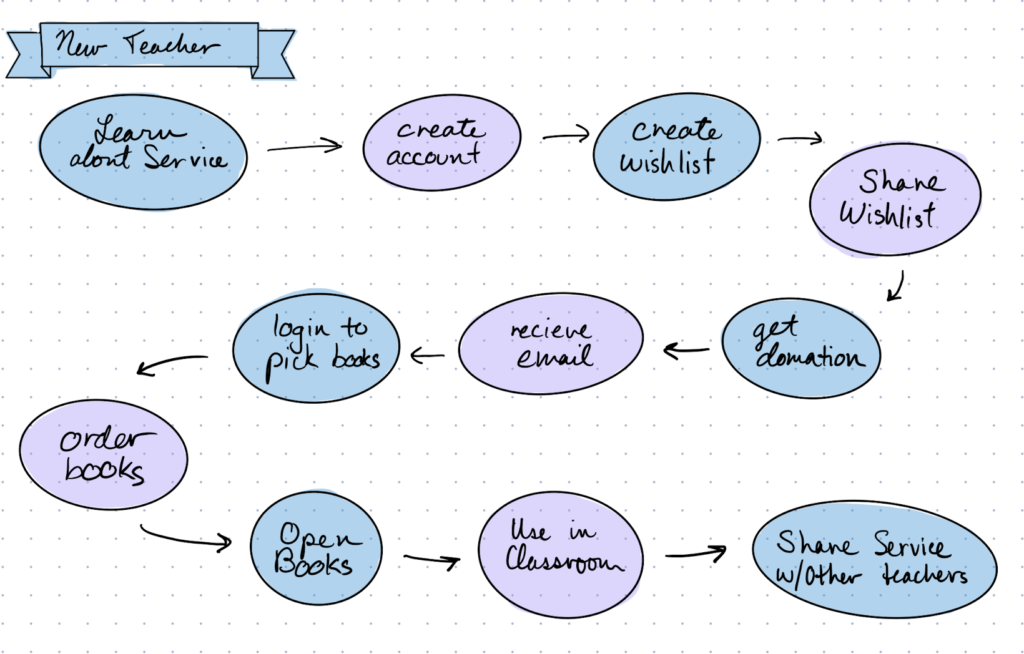
After choosing to create a website, I worked through a few service maps to work out the journey the different audiences of the site would go through. This is the map for a teacher joining Pippi. My goal is that this would become cyclical in the sense that the teachers using the service would share it to others and then join their own service loop. I also mapped the experience of a donor to the site.
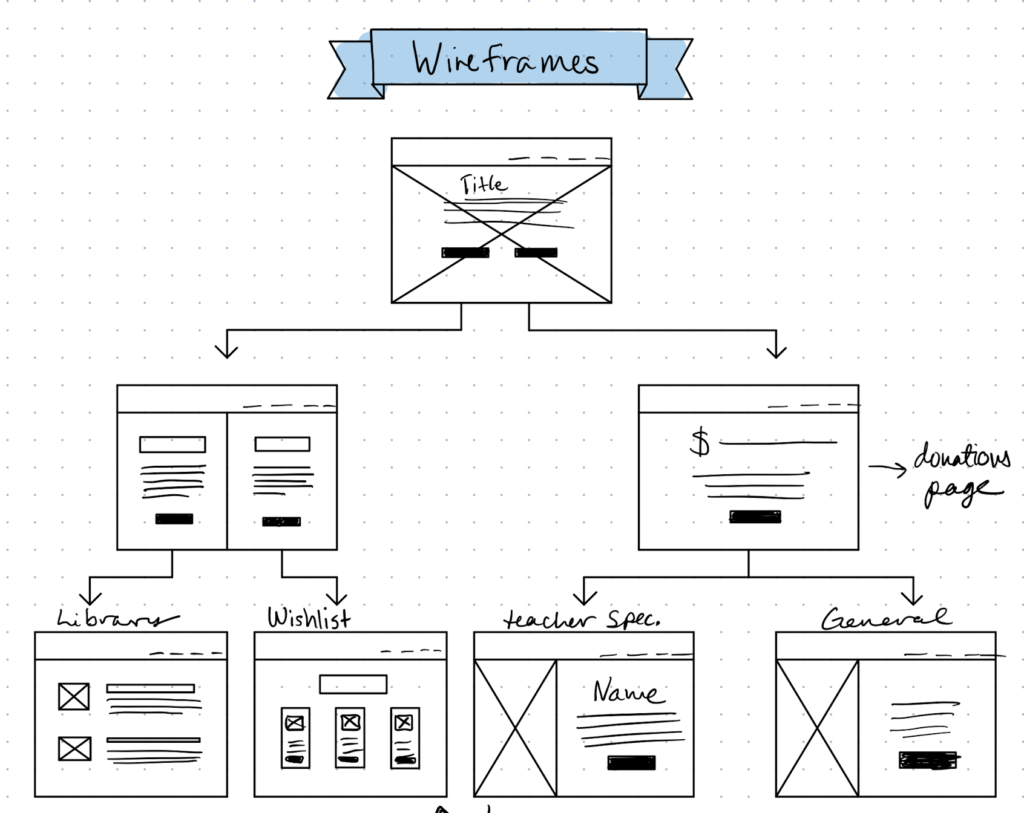
These are the beginning of the wireframes I created once I knew how I wanted the users to work through the website. This is from when the original concept included a library option. Here was the beginning of me organizing my thoughts and figuring out what types of pages to build for my test subjects to feel like this is a real product they are interacting with.
In order to test my product, I went back to those who had helped me originally with my research: the teachers. I told them about my service and then allowed them to work through the site on their own so they might have a more organic experience with it. Going back to the same interviewees was a very rewarding experience because they all seemed genuinely excited and interested in my solution. One teacher even shared with me that this option would be incredibly helpful because it takes the principles of a Scholastic Book Fair but allows them more customization with their selections.
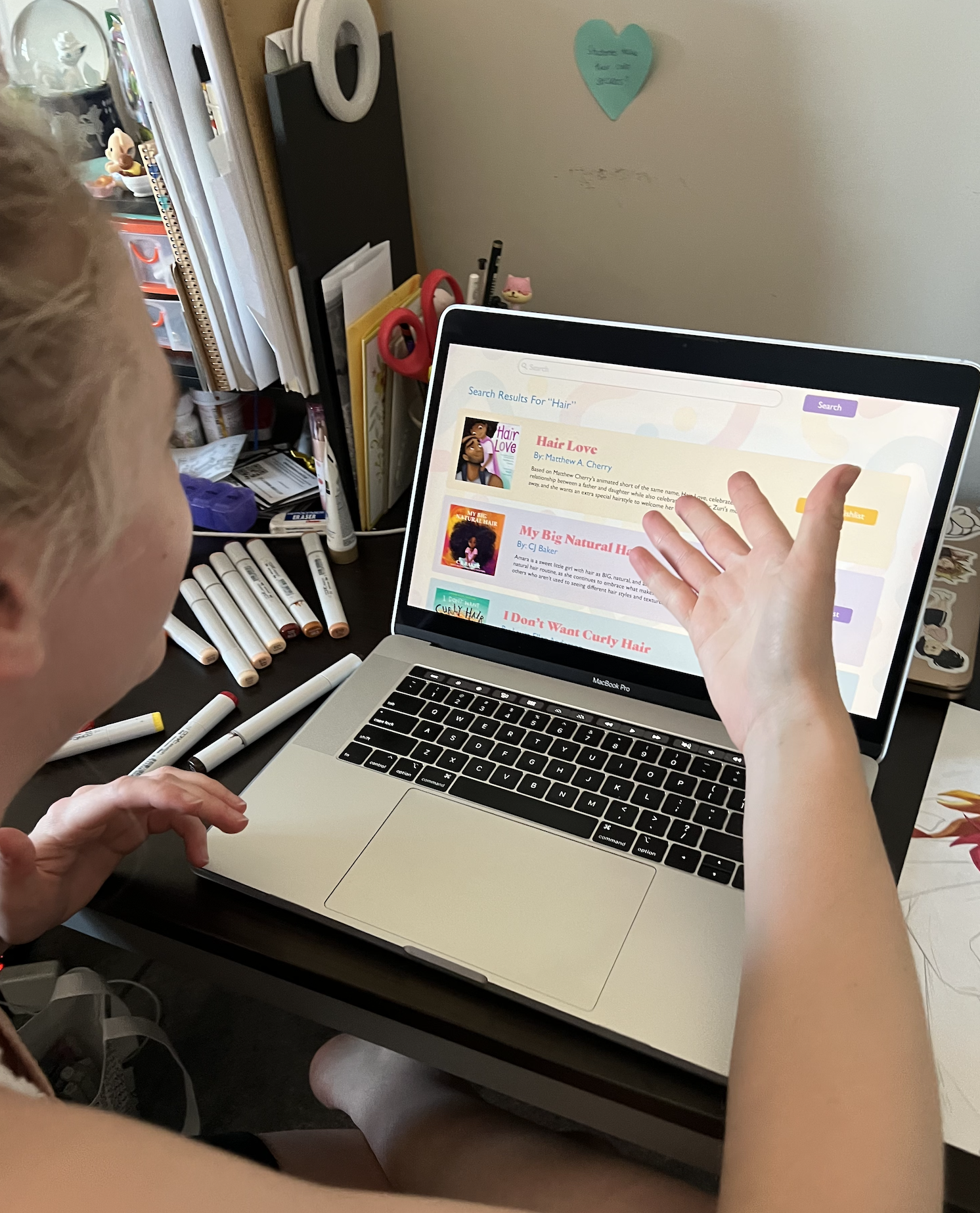
When speaking to a different subject, who was aware of the initial scope of the project including a library with lesson plans, she said she was saddened that feature didn’t make it to the prototype. Upon further thinking about the reason I removed it, which was that kids to learn from and enjoy books better when they’re in their hands, I know realize I could have instead included a database of lesson plans for the different books offered on our site. That way it would still encourage teachers to get the physical books in student’s hands but also ease the burden of creating a lesson plan from scratch.
If I were to revisit this project, I would most definitely build that in as a feature because it does match up with my insights gathered at the interview stage. I want to make solving the issue of lacking representation easy for teachers, not any for of additional burden they feel they need to move mountains to solve. They have very busy lives and a lot they need to get done so the addition of this would be very beneficial.
Design Solution
Meet Pippi!
Pippi is a service that allows people to donate money either to a teacher, a school, or a general fund to allow teachers to purchase children’s books with strong female characters. They are able to build out their own wishlist with books they want or look into our recommendations and pick from there. Once they purchase a book, it is sent to the school for the teacher to use in the classroom.
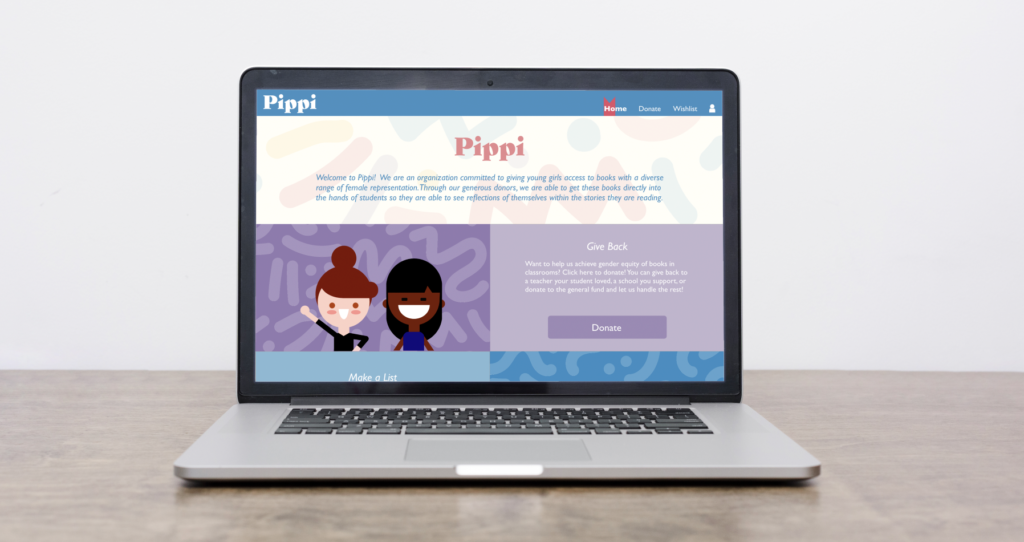
Once launching the website, users will be able to either go in and donate funds or create/maintain their own personal wishlist. Once they enter their personal user flow, they will see whatever functions they have need for.
A teacher utilizing this service also has the option to send out her wishlist either by email, or social media posts. This not only helps them to gather donors, it spreads the word about Pippi to others who may be interested in it. Many teachers are friends with and follow each other so any social posts would be also serving my target audience.
Below are two examples of the differing views. Those who have come to donate are able to do so quickly and easily. If they do not know of a specific teacher or list they want to donate to, they are able to donate to a general fun which gives that money out at random. The teacher profile is more involved as they are the ones curating the list. When they receive donations, an email is sent to them so they can log on and use those funds. They are then able to walk through like a customer and purchase their books for their classroom.
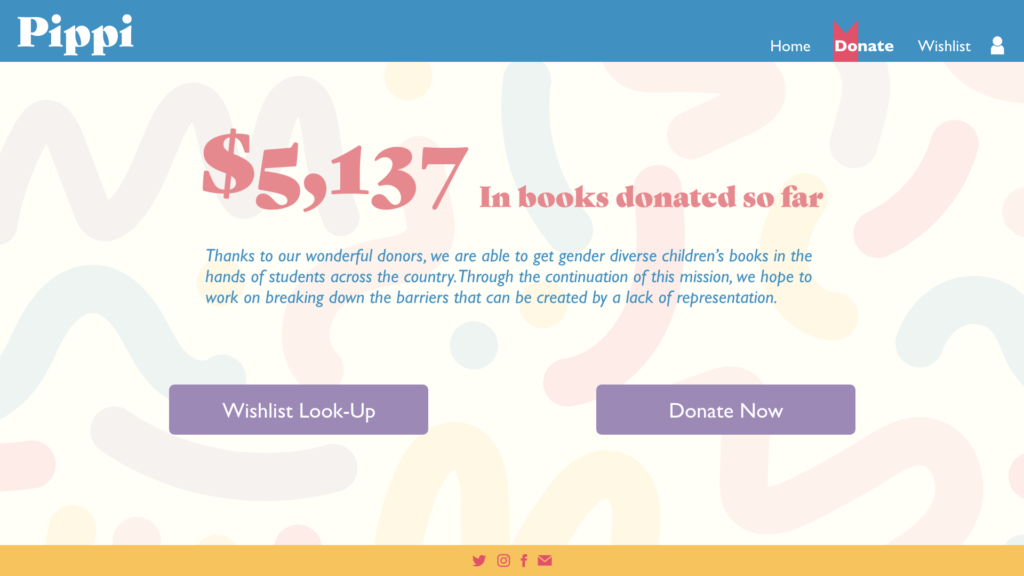
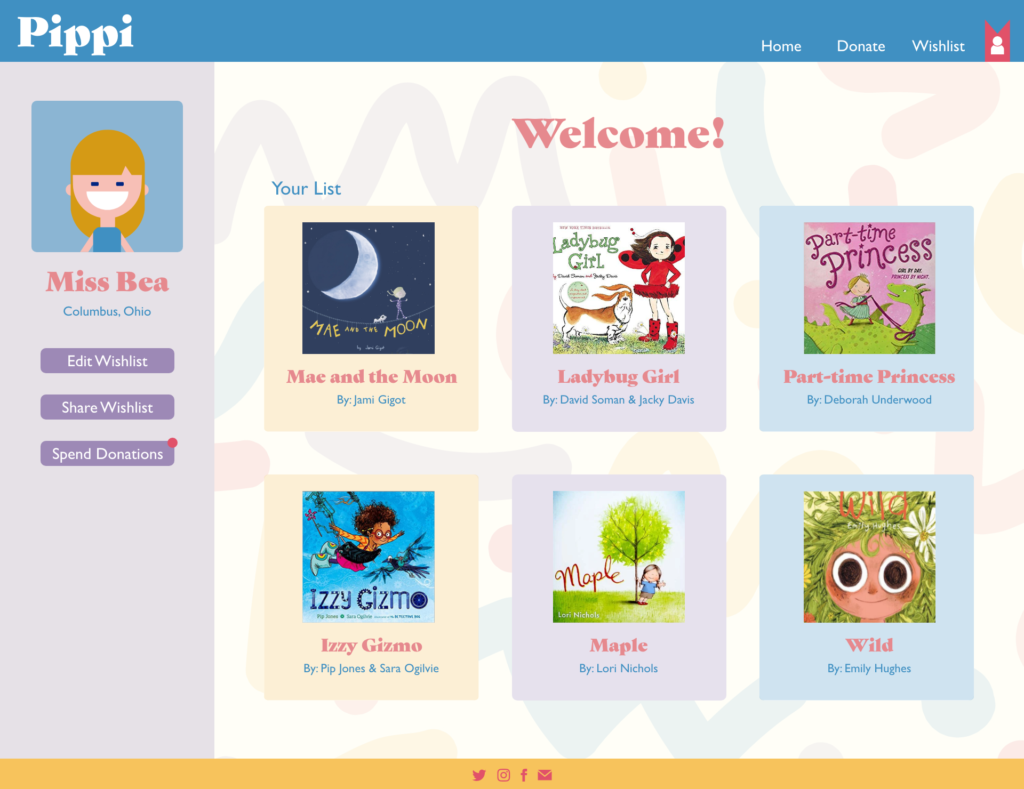
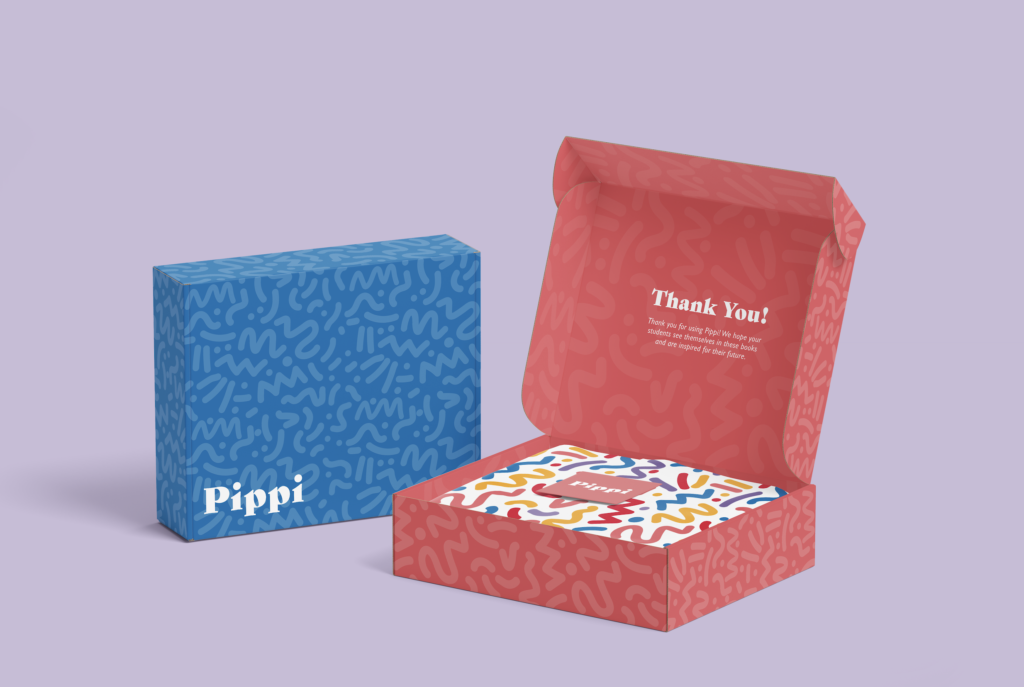
After these books are purchased, they will be sent to the teacher or school by Pippi. I wanted the packaging for the shipper to match the fun and childlike design I used for my website so it would bring some of that fun energy into the classroom. Plus it makes receiving the box way more interesting and fun for the students if the teacher involves them in the unboxing process.